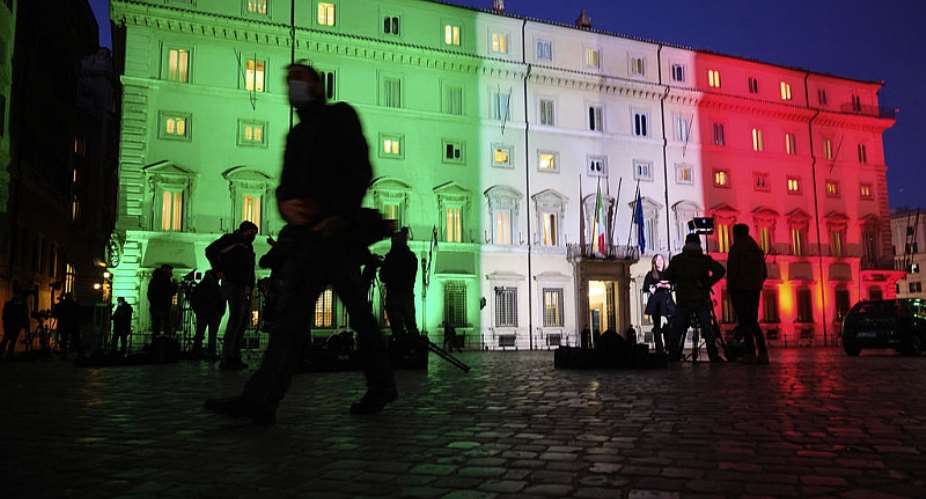Measures to limit Covid-19 infections have come into force in Italy after Prime Minister Giuseppe Conte signed a new emergency decree on Saturday, with a return to a three zone system. Although more than one million people have been vaccinated in the country, daily cases continue to hover around 15-20,000 and hospitals remain under pressure.
Under the new emergency decree signed this week, Italy has returned to following a coloured tier system in which residents of high-risk red zones should not leave their homes unless strictly necessary.
A nightly curfew between 10 pm and 5 am has also been maintained.
Italians are exhausted with the on-going closures and a dismal economic situation but have accepted that the situation is far from under control. The death toll from Covid-19 has well exceeded 81,000, with a daily figure of 400-600 a day on average according to the health authorities.
However, the vaccination program has been moving faster than expected with people aged over 80 receiving their first injections this week instead of early February as originally planned.
Three 'red' zones
From Sunday 3 Italian regions turn “red” where residents are living in a state of near-total lockdown.
These include the northern region of Lombardy where only supermarkets, pharmacies and other stores selling basic items can stay open. The other two are Sicily and Bolzano.
The majority of Italian regions, 14, are set at medium-risk orange, and 5 are low-risk yellow.
In orange areas, restaurants and bars are closed except for take-away and delivery, as in red zones, but shops are open.
Only those living in low-risk yellow zones are able to go to bars and restaurants, which can remain open until 6 pm.
The measures will be effective from Sunday 17 January.
On Friday evening, there was a call on Twitter for civil disobedience to protest against the curfew and the economic hardship faced by restaurants owners. Several chose to stay open and their customers posted videos online under the hashtag #IoApro, such as in Bologna.
The Italian government said Friday it would seek to borrow an extra 32 billion euros to help businesses hurt by coronavirus restrictions.
Museums, schools to re-open cautiously
However, for some, there was a glimmer of hope. Museums in yellow zones for example, will be able to re-open to the public in limited numbers during weekdays starting next Monday.
As far as high schools are concerned, from Monday, all those regions who are not “red” will be able to re-open and 50-75% of students will be able to attend their classes, the others will continue with distance learning. The door is open for regions to adopt more restrictive measures for schools if they deem this is necessary.
But as far as visits to relatives and friends, these remain restricted to once a day and only a maximum of two people from outside the household.
No skiing until mid February
The government has also decided to prolong the rule of no travel between regions until February 15.
Gyms and swimming pools for the time being will remain closed across the country and in spite on heavy snowfalls this winter, there will be no skiing in Italy at least until February 15.
The new decree also established a new white zone which will be for those regions that are able to reach a rate of no more than 50 positive infections for every 100,000 inhabitants.
No region in Italy is in this situation at the moment and experts continue to warn that the rate of infections should not be underestimated.





 This IMANI job no dey pap; the people you are fighting for are always fighting y...
This IMANI job no dey pap; the people you are fighting for are always fighting y...
 Prof. Naana Opoku-Agyemang has changed; you can see a certain sense of urgency –...
Prof. Naana Opoku-Agyemang has changed; you can see a certain sense of urgency –...
 MFWA Executive Director slams Akoma FM for engaging in ‘irresponsible’ media pra...
MFWA Executive Director slams Akoma FM for engaging in ‘irresponsible’ media pra...
 ‘Women must become millionaires too’ — Prof Jane Naana on establishment of Women...
‘Women must become millionaires too’ — Prof Jane Naana on establishment of Women...
 Some believe only in Ghanaian votes, not Ghana — Kofi Asare jabs politicians
Some believe only in Ghanaian votes, not Ghana — Kofi Asare jabs politicians
 Plan to make BEST sole aggregator of Sentuo Oil Refinery will create market chal...
Plan to make BEST sole aggregator of Sentuo Oil Refinery will create market chal...
 2024 elections: I can't have the man I removed from office as my successor — Aku...
2024 elections: I can't have the man I removed from office as my successor — Aku...
 2024 Elections: Immediate-past NPP Germany Branch Chairman garners massive votes...
2024 Elections: Immediate-past NPP Germany Branch Chairman garners massive votes...
 Gov’t focused on making Ghana energy self-sufficient, eco-friendly – Akufo-Addo
Gov’t focused on making Ghana energy self-sufficient, eco-friendly – Akufo-Addo
 April 25: Cedi sells at GHS13.74 to $1, GHS13.14 on BoG interbank
April 25: Cedi sells at GHS13.74 to $1, GHS13.14 on BoG interbank
